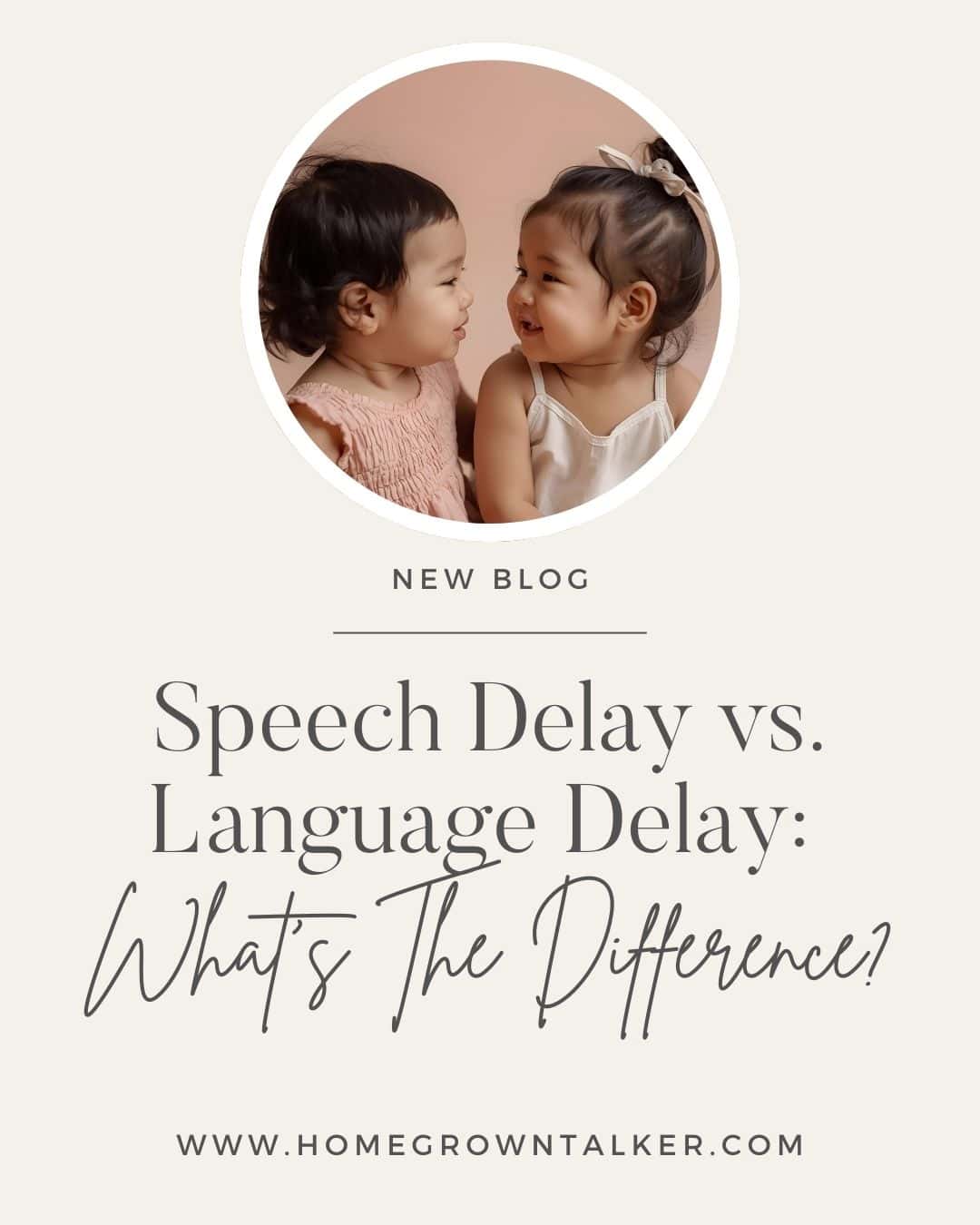Speech Delay vs. Language Delay: What’s the Difference?
Many parents confuse speech delay with language delay—knowing the difference of a speech delay vs language delay, is the first step to helping your child thrive. As both a mom of a child with special needs and a pediatric speech-language pathologist, I’ve witnessed firsthand how confusing and scary it can feel when your child isn’t talking or seems “behind.”

My goal in this post is to help you:
(And yes—always check with your pediatrician or local SLP for your child’s unique needs.)
1) One
Understand what the difference is between speech delay and language delay
2) Two
Learn the signs to watch for.
3)Three
Give you some home strategies and guidance so you feel empowered.
Liability reminder: This article is not medical advice. Always consult your child’s pediatrician and, if needed, request a speech-language evaluation before making treatment decisions.
Defining Speech Delay vs. Language Delay
Before we dive into signs and strategies, let’s clarify what “speech” and “language” actually mean in child development. These are related, but distinct, skills.
Language is the system we use to communicate: it involves receptive language (how a child understands or processes what they hear) and expressive language (how a child conveys ideas, thoughts, needs, feelings through words, gestures, sentences, etc.). Click here for this research.
Speech refers to the physical act of producing sounds, words, and sentences—what our mouths, tongue, lips, jaws, vocal cords, and breathing do to make intelligible sounds.
In short:
speech = how you say sounds and words;
language = what you mean, and how you understand and express meaning.
Because they are different processes, a child might have mostly a speech delay (motor or articulation issues) while their language (vocabulary, sentence structure, comprehension) is developing on time—or vice versa. In many cases, both are affected. Click here for this research.
Some Terms You Might See When Researching a Speech Delay vs Language Delay
- Late talker / late language emergence: when toddlers are slower to start talking but may grow into more typical language over time. Click here to read ASHA’s statement on late language emergence.
- Developmental speech delay or speech sound disorder: persistent difficulty producing sounds clearly. Click here to read more about this medical definition.
- Expressive language disorder: when a child’s ability to use language to express themselves is behind expectations.
- Receptive language disorder: when a child struggles with listening, understanding directions, or comprehending language input.
- Developmental language disorder (DLD): when language skills are significantly behind and meet criteria such that they affect daily functioning, without being fully explained by another condition (e.g., hearing loss, autism). Click here to read the NIH’s speech milestones.
Common Signs of Speech Delay
Speech delay (or a speech sound disorder) is primarily about how the child produces words. Here are signs you might notice:
- Their speech is often unclear, even to familiar caregivers (e.g. “I want ba” for “ball”).
- They omit sounds (e.g. “nake” for “snake”), distort (slushy “s”), substitute sounds (e.g. “tat” for “cat”), or simplify clusters (e.g. “pane” for “plane”).
- They have difficulty with certain consonants—for example, young toddlers around 2–3 may mispronounce p, b, m, h, w; by age 3–4 you might see errors in k, g, f, t, d, n. Click here for this normative data.
- They struggle to put two sounds together or initiate sound combinations.
- They may produce fewer consonant sounds in babble or early speech.
- They may prefer gestures or pointing rather than talking because it’s easier.
- Frustration in being understood is common, especially as their social world expands.
- Their errors are persistent past the age when most peers have “grown out” of them.
Because articulation is a motor process, speech delays may also occur when there is an underlying oral-motor difficulty, muscle weakness, or structural issue (e.g. tongue tie) affecting how the child moves their speech mechanism.
Common Signs of Language Delay
A language delay affects meaning and communication. These are signs that the language system is lagging:
- Receptive (understanding) side:
- Doesn’t respond to name reliably by about 9–12 months
- Doesn’t follow simple directions (e.g. “Bring me the ball”)
- Seems not to understand questions or simple stories
- Poor or slow growth in vocabulary comprehension
- Expressive (speaking) side:
- Very few words by 18 months (e.g. fewer than 10)
- Doesn’t combine words by age 2 (e.g. “more juice,” “mommy help”)
- Uses short or incomplete sentences, omits “little” words (e.g. “in,” “on,” “is”)
- Trouble using pronouns, plurals, verbs correctly
- Limited vocabulary for their age
- Difficulty telling simple stories or describing events
- Speech might be more understandable than expected given how much they try to express
- Social communication struggles: difficulty starting or maintaining conversation, turn-taking
Some children have mixed receptive–expressive delays, meaning they both struggle to understand language input and to use language expressively. Click here for this normative data.
Did you know?
- If a child continues to lag in language beyond early preschool years, we often consider developmental language disorder (DLD). Around 2–7% of children may experience persistent language difficulties.
Overlap and Co-Occurrence of Speech Vs Language Delay
In real life, speech and language are intertwined, and it’s common for children to have difficulty with both. Some overlap to note:
- A child might have good language but poor speech: They know many words and can understand, but their pronunciation (how they say the word) is hard to follow.
- A child might have clear speech but limited language: They can produce sounds clearly, but they struggle to form sentences or understand verbal directions (especially in group settings).
- Sometimes what looks like a “speech problem” is really a language issue (e.g. the child uses simpler words or structures because they don’t have the underlying vocabulary or grammar).
- Because language helps guide speech learning (through hearing and internal modeling), a weakness in one can negatively impact the other over time.

children with speech/language delays are at higher risk for later difficulties with reading, writing, attention, and social skills if not supported. Click here for this research.
How Speech Therapy Addresses Both Speech and Language Delays
As a pediatric SLP and mama, I have deep understanding in the power of early, targeted intervention. Here’s how speech-language therapy can help—and how you can partner with it at home.
What happens in therapy
- Assessment & goal-setting: The SLP will evaluate your child’s speech, language, hearing, oral motor skills, and other relevant areas. Based on that, the therapist crafts individualized goals.
- Targeted drills and play: Children work on sounds (e.g. articulation), combining words, expanding vocabulary, improving sentence structure, comprehension tasks, etc. Therapists use play-based activities to make it fun.
- Modeling & scaffolding: The therapist speaks the correct forms, simplifies, expands, and supports gradually so your child “levels up” language.
- Parent training & home carryover: Good therapy always involves coaching families so gains aren’t limited to therapy time.
- Progress monitoring: Periodic reassessments ensure the child is making gains; goals may shift as your child grows.
Why this matters.
Speech therapy supports both speech and language by embedding motor practice within meaningful communication. In effect, you don’t just teach sounds—you teach how to use those sounds in real interactions with language.
According to clinical evidence, children with language delays show measurable improvements in receptive and expressive language when engaged in intervention. And therapy helps with confidence, social engagement, school readiness, and quality of life. Click here for the research.
When Parents Should Seek Evaluation for Speech and Language Delays
As a mom, I get it: you don’t want to overreact—but you also don’t want to delay help. Here are some of my previous articles discussing red flags and guidelines!







